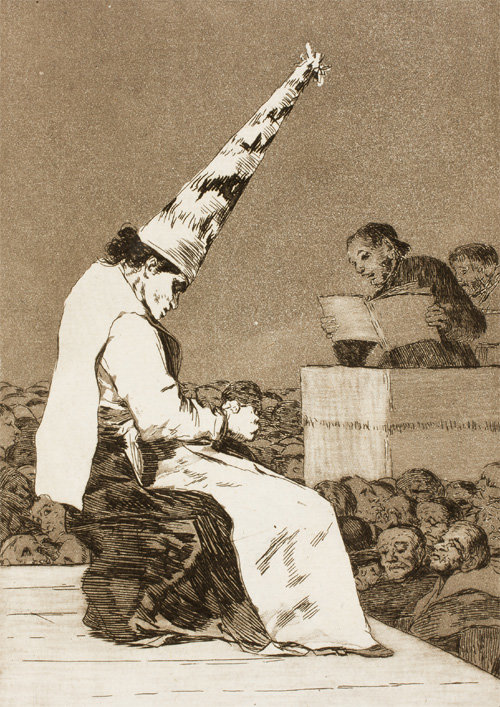Satires sold at a pharmacy
Satires sold at a pharmacy
Posted March. 19, 2020 07:54,
Updated March. 19, 2020 07:54

Satire requires an insight on the world. Renowned Spanish artist Francisco de Goya satirized the ruling class through his art even though he was a court painter. He produced 80 copperplate prints under the title of “Les Caprices” from 1797 to 1798 and published 300 books with them. And he sold them at a neighborhood pharmacy, not to art dealers. Why did he sell his artworks at a pharmacy? Were they popular?
The 80 copperplate prints were full of images criticizing Spanish society in those days including the ignorance and incompetence of the ruling class, corruption of churches and authorities, arranged marriages, beggars, prostitutes, wide-spread superstition and the downfall of ordinary people. This is the 23rd print that depicts an unfair religious trial. The prisoner in a long cone hat with her hands tied is a disabled woman named Perico who was arrested on a charge of selling a love potion. She is listening to the ruling read out by the presiding judge sitting among the crowd with her head down. It seems that she already received a great deal of criticism. She is about to die because of a crime as trivial as “a fleck of dust,” which is the title of the print. “It is wrong to treat an honorable woman who served everyone well,” said Goya, who was filled with indignation, while carving out this scene on a copperplate.
Selling these satirical works at a pharmacy entailed a great risk. But as soon as he put up a sales advertisement on a local newspaper, 27 copies were sold. The pharmacy was the best place to sell his artworks as he could check the response of the public immediately. Goya must have felt dangerous as Spain was laden with imperious churches and ruthless autocrats. He was well-liked by Charles IV but feared that he could be put on trial and punished for it, which was why he decided to stop selling his works. In 1803, he handed over the copperplates and prints to the king in exchange for personal protection. It was a realistic compromise to continue on with his career as an artist.




![‘친구’란 말에, 치매 아버지는 고향땅 800평을 팔았다[히어로콘텐츠/헌트①-上]](https://dimg.donga.com/c/138/175/90/1/wps/NEWS/IMAGE/2025/12/14/132961909.1.jpg)

![10번 북송된 그녀, 73만 유튜버 되다…탈북 유튜브 ‘유미카’ 뒷이야기[주성하의 북에서 온 이웃]](https://dimg.donga.com/c/138/175/90/1/wps/NEWS/IMAGE/2025/12/12/132938957.1.jpg)
